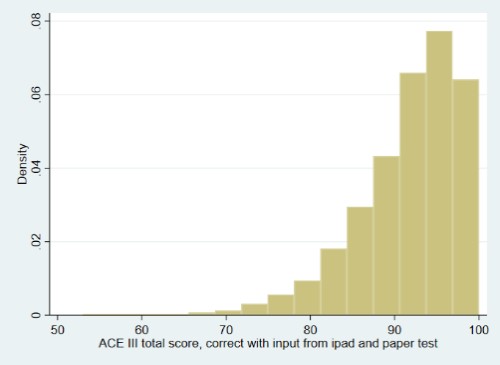The MRC National Survey of Health of Development (NSHD) assessed their cohort members (CMs) during the study’s age 68-70 sweep using the Addenbrooke’s Cognitive Examination-III (ACE-III).
Details on this measure and the data collected from the CMs are outlined in the table below.
| Years of data collection: | 2014-2016 |
| Domain: | Verbal and non-verbal ability |
| Measures: | Attention/Orientation |
| Memory | |
| Language | |
| Verbal Fluency | |
| Visuospatial Skills | |
| CHC: | G (general ability) |
| CLOSER Source: | Explore this sweep in CLOSER Discovery: NSHD 2014 (Age 68) and 2015 (Age 69) (links open in a new tab) |
| Administration method: | Administered by a research nurse. Mostly conducted using the ACEmobile app, installed on an iPad, with prompts to guide interviewer through the process. Pen and paper used where necessary (e.g. drawing tests). |
| Procedure: | The ACE-III was designed to detect mild dementia and distinguish between Alzheimer's disease (AD) and Frontotemporal dementia (FTD) (Mathuranath et al., 2000). Although it may be considered a measure of general cognitive ability, it was developed as a screen for impairment for use in clinical settings. It contains tasks/questions that measure 5 different cognitive domains: attention and orientation (scored 0 - 18); verbal fluency (0 - 14); memory (0 - 26); language (0 - 26); and visuospatial function (0 - 16). The tasks/questions used to assess the 5 specific domains are outlined separately in the next sections. Responses from the 5 domains can be summed to create an overall cognitive functioning score (0 - 100). ACE-III was administered by the interviewers via iPad using ACEmobile (http://www.acemobile.org). Where this was not possible, a paper version was used. All offline scoring was undertaken by trained personnel. |
| Link to questionnaire: | https://skylark.ucl.ac.uk/NSHD/lib/exe/fetch.php?media=mrepo:ace-iii.pdf (opens in new tab) |
| Scoring: | One mark per correct item (0 - 100) |
| Item-level variable(s): | ACESCRAT15x - ACEVISIOTOT15x |
| Total score/derived variable(s): | ACETOTFIN15x, MINIACE15x |
| Descriptives: | Raw score |
| N = 1,762 | |
| Range = 53 - 100 | |
| Mean = 91.52 | |
| SD = 6.01 | |
(click image to enlarge) |
|
| Age of participants (months): | Mean = 834.14, SD = 2.93, Range = 828 - 848 |
| Other sweep and/or cohort: | None |
| Source: | Mathuranath, P. S., Nestor, P. J., Berrios, G. E., Rakowicz, W., & Hodges, J. R. (2000). A brief cognitive test battery to differentiate Alzheimer's disease and frontotemporal dementia. Neurology, 55(11), 1613-1620. |
| Technical resources: | Noone, P. (2015). Addenbrooke's cognitive examination-III. Occupational Medicine, 65(5), 418-420. |
| Example articles: | Matías-Guiu, J. A., Valles-Salgado, M., Rognoni, T., Hamre-Gil, F., Moreno-Ramos, T., & Matías-Guiu, J. (2017). Comparative diagnostic accuracy of the ACE-III, MIS, MMSE, MoCA, and RUDAS for screening of Alzheimer Disease. Dementia and Geriatric Cognitive Disorders, 43(5-6), 237-246. |
| James, S. N., Davis, D., O'Hare, C., Sharma, N., John, A., Gaysina, D., ... & Richards, M. (2018). Lifetime affective problems and later-life cognitive state: Over 50 years of follow-up in a British birth cohort study. Journal of Affective Disorders, 241, 348-355. |
Go to:
- Overview of all cognitive measures in NSHD
- Overview of adulthood cognitive measures across all studies
This page is part of CLOSER’s ‘A guide to the cognitive measures in five British birth cohort studies’.
